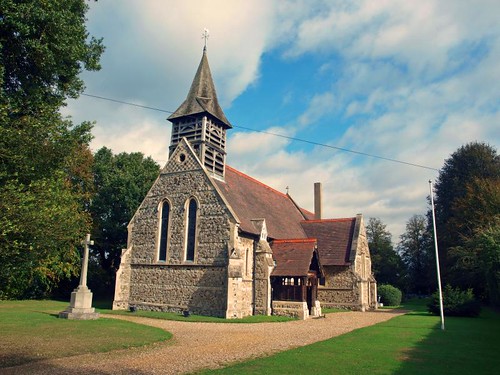ALL SAINTS. In ruins and at the time of writing completely neglected, with bushes and weeds growing rank inside the nave and aisle. Brick chancel of the early C16, with two-Light brick-windows in the S wall. Nave with two-bay N arcade. The pier is of brick, octagonal and heavy. In the nave S wall is one four-light window of brick.*
* Wall paintings removed to the Victoria and Albert Museum.
EAST HANNINGFIELD. Far from any town it stands, on a ridge with long views every way. Wide grass borders to the highway give a charm to its neat cottages and the modern church has a prosperous look. The vicar’s garden boasts the oldest well in the county, 480 feet deep. Close to the village are two Elizabethan farms with diagonal chimneys, but the church of medieval days is a ruin down the hill. It has given to South Kensington a wall-painting of great value, a treasure 600 years old showing Adam with his spade, Eve with her spindle, and Catherine with her wheel. For many years this painting was exposed to the open sky in the ivied ruins of the nave by the old chancel, now only used for funerals.
Simon K -
Leaving Sandon, it was a good ten miles to the next church I wanted to visit, so I had selected a few things to entertain me along the way. The first of these was actually a church! This was All Saints, East Hanningfield.
The sign says the churchwarden will be happy to come and show you around - show you around what?, I wondered, since there really wasn't much
to it.
I found a Japanese POW memorial in the churchyard, and some good cast iron gravemarkers, presumably from Maldon, and then headed on.
Flickr.
Simon K -
Leaving Sandon, it was a good ten miles to the next church I wanted to visit, so I had selected a few things to entertain me along the way. The first of these was actually a church! This was All Saints, East Hanningfield.
Locked with a keyholder notice. This is one of the numerous little
Victorian churches rebuilt or planted by the then-Diocese of Rochester
in the hamlets around Chelmsford and Brentwood in the later years of
the 19th Century. Some are now private houses, some are still in use -
this one is. What makes it attractive is that it is entirely in the
vernacular Essex rural style, with a little bellcote at the east end.
I found a Japanese POW memorial in the churchyard, and some good cast iron gravemarkers, presumably from Maldon, and then headed on.
Flickr.

No comments:
Post a Comment